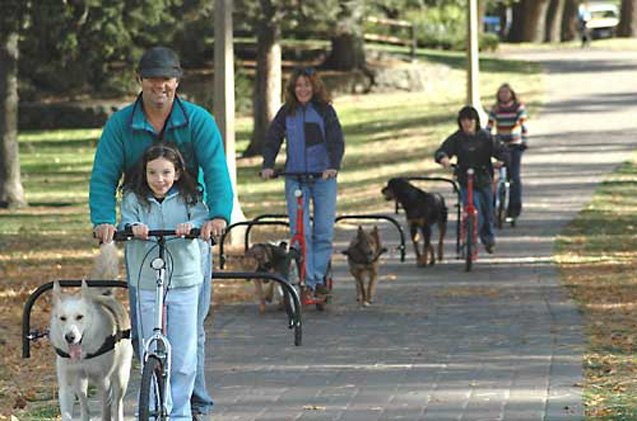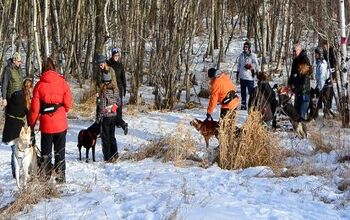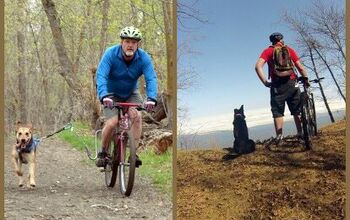Pulling For Urban Mushing – Is It The Right Activity For Your Dog?

There are some dogs that need more exercise than others. Walks around the blocks and trips to the dog park aren’t going to cut it. If you want to give your dog an exceptional workout, you should try your hand at Urban Mushing.
There are different types of Urban Mushing – dryland mushing, dog scootering, Bikejoring and dog carting – but the concept is basically the same. A dog or team of dogs pulls you on a scooter, bike or cart (the point is that what the dog is pulling should have wheels). Whereas mushing is done in the winter with dogs pulling a sled in snow-covered regions, you can enjoy the benefits of Urban Mushing no matter where you live. It is recommended that urban mushing should be done during the colder months, as it’s easy for dogs to overheat. But you can do it in warmer climates, as long as you monitor your dog closely and keep sessions short.
What kind of dog breeds can be urban mushers? Any dog can be used, as long as they have a high drive, but there are certain dog breeds that are more popular to the sport. These include used Pitbulls, Alaskan Huskies, Eurohound/Sled Hounds, Siberian Huskies, Samoyeds, Malamutes and Pointers. But really, all you need is a dog that can learn mushing commands, can be taught to pull and run and like to be active.
Dryland/Cart mushing: This type of mushing involves a cart, trike or dryland rig that is attached to the dog (the same way a dog team would be attached to a sled). Sporting either three or four wheels, the driver can sit or stand in the cart, depending on the type used. There are even events that dry mushers can take part in – the IFSS Dryland World Championship is the big dryland mushing event and is sponsored by the International Federation of Sled Dog Sports.
Dog scootering: This one looks like fun and is accessible to anybody with a scooter. In dog scootering, one or more dogs pull a person riding an unmotorized kick scooter. Like other Urban Mushing types, dogs wear harnesses and are hooked to the scooter with a gangline that incorporates a bungee cord. In this type of Urban Mushing, dogs can also be hooked up to the side of the scooter. This is considered to be a safer Urban Mushing alternative, as dogs can “trot” alongside the scooter. The “Custom Fit” Bolt-on Dog Pulling Systems from dogpoweredscooter.com looks safe and sturdy, and fits on any scooter. The dog pulls while you steer and control the breaks. This sideway guiding system will be attractive to people starting out and concerned about safety – it’s the most effective way to control your dog and the easiest way to master this type of mushing. And dog scootering is the most accessible to people of all walks of life – kids, seniors and mobility challenged people can take part in this activity.
Bikejoring: As you can tell by the first part of its name, this type of Urban Mushing has dogs pulling a bicycle. A dog or team of dogs is attached to a towline that they have to pull and run ahead of a cyclist. You’ll need special equipment – dogs will need to be fitted with suitable harnesses (try an x-back harness). If you’ve got more than one dog pulling, the harness needs to be attached to a gang line and a bungee towline, which clips to the front of the bicycle. It’s best to do your Bikejoring on soft trails and never on paved surfaces, as this could hurt their paws or limbs.
Depending on where you live, you’ll often find associations affiliated with different Urban Mushing activities. There are even Meetup.com groups that dedicated to likeminded individuals, helping them to connect and share their passion with other dog owners.
No matter which type of Urban Mushing you decide to try out, be sure to talk to someone that’s already involved in the activity and buy the proper equipment. Do your homework and research the sport on the Internet. There are numerous websites and videos that will help guide you to proper practices, with advice culled from experience. This will make all the difference when it comes to you and your dog’s safety and enjoyment.
Photo credits: dogpoweredscooter.com; Toivocoughlin/Wikimedia; Randi Hausken/Flickr

Amy Tokic, Editor of PetGuide.com, is a passionate animal lover and proud pet parent of Oscar, a Shih Tzu/Chihuahua cross, and Zed, a Japanese Chin. Her love of animals began in kindergarten, when she brought her stuffed dog Snoopy into class with her every day. Now, she writes about her adventures in pet ownership and tirelessly researches products, news and health related issues she can share with other animal enthusiasts. In her free time, Amy loves perusing used book and record stores, obsessing over the latest pet products available and chasing squirrels with wild abandon (a habit attributed to spending too much time with her pooches).
More by Amy Tokic


























